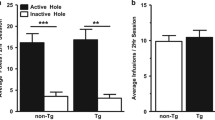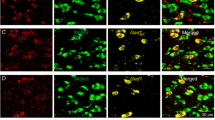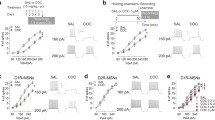Abstract
The prefrontal cortex (PFC) is dysregulated in neuroAIDS and during cocaine abuse. Repeated cocaine treatment upregulates voltage gated L-type Ca2+ channels in pyramidal neurons within the rat medial PFC (mPFC). L-type Ca2+ channels are also upregulated by the HIV-1 neurotoxic protein, Tat, but the role of Tat in pyramidal cell function is unknown. This represents a major knowledge gap as PFC pyramidal neurons are important mediators of behaviors that are disrupted in neuroAIDS and by chronic cocaine exposure. To determine if L-channel-mediated Ca2+ dysregulation in mPFC pyramidal neurons are a common neuropathogenic site for Tat and chronic cocaine, we evaluated the electrophysiological effects of recombinant Tat on these neurons in forebrain slices taken from rats 1–3 days after five, once-daily treatments of cocaine (15 mg/kg, ip) or saline. In saline-treated rats, bath-applied Tat facilitated membrane depolarization and firing. Ca2+ influx was increased (indicated by prolonged Ca2+ spikes) with low concentrations of Tat (10-40nM), but reduced by higher concentrations (80-160nM), the latter likely reflecting dysfunction associated with excessive excitation. Tat-mediated effects were detected during NMDA/AMPA receptor blockade, and abolished by blocking activated L-channels with diltiazem. In neurons from cocaine-treated rats, the Tat-induced effects on evoked firing and Ca2+ spikes were significantly enhanced above that obtained with Tat in slices from saline-treated rats. Thus, glutamatergic receptor-independent over-activation of L-channels contributed to the Tat-induced hyper-reactivity of mPFC pyramidal neurons to excitatory stimuli, which was exacerbated in rats repeatedly exposed to cocaine. Such effects may contribute to the exaggerated neuropathology reported for HIV+ cocaine-abusing individuals.






Similar content being viewed by others

References
Allen TGJ, Sim JA, Brown DA (1993) The whole-cell calcium current in acutely dissociated magnocellular cholinergic basal forebrain neurones of the rat. J Physiol Lond 460:91–116
Antinori A et al (2007) Updated research nosology for HIV-associated neurocognitive disorders. Neurology 69:1789–1799
Avraham HK, Jiang S, Lee TH, Prakash O, Avraham S (2004) HIV-1 Tat-mediated effects on focal adhesion assembly and permeability in brain microvascular endothelial cells. J Immunol 173:6228–6233
Bonavia R, Bajetto A, Barbero S, Albini A, Noonan DM, Schettini G (2001) HIV-1 Tat causes apoptotic death and calcium homeostasis alterations in rat neurons. Biochem Biophys Res Commun 288:301–308
Brailoiu GC, Brailoiu E, Chang JK, Dun NJ (2008) Excitatory effects of human immunodeficiency virus 1 Tat on cultured rat cerebral cortical neurons. Neuroscience 151:701–710
Campbell GR, Loret EP (2009) What does the structure-function relationship of the HIV-1 Tat protein teach us about developing an AIDS vaccine? Retrovirology 6:50
Catterall WA, Striessnig J, Snutch TP, Perez-Reyes E (2003) International Union of Pharmacology. XL. Compendium of voltage-gated ion channels: calcium channels. Pharmacol Rev 55:579–581
Cheng J, Nath A, Knudsen B, Hochman S, Geiger JD, Ma M, Magnuson DS (1998) Neuronal excitatory properties of human immunodeficiency virus type 1 Tat protein. Neuroscience 82:97–106
Cohn SE, Jiang H, McCutchan JA, Koletar SL et al (2011) Association of ongoing drug and alcohol use with non-adherence to aniretroviral therapy and higher risk of AIDS and death: results from ACTG 362. AIDS Care 23:775–785
Contreras X, Bennasser Y, Chazal N, Moreau M, Leclerc C, Tkaczuk J, Bahraoui E (2005) Human immunodeficiency virus type 1 Tat protein induces an intracellular calcium increase in human monocytes that requires DHP receptors: involvement in TNF-alpha production. Virology 332:316–328
Dolmetsch RE, Pajvani U, Fife K, Spotts JM, Greenberg ME (2001) Signaling to the nucleus by an L-type calcium channel-calmodulin complex through the MAP kinase pathway. Science 294:333–339
Eugenin EA, King JE, Nath A, Calderon TM, Zukin RS, Bennett MV, Berman JW (2007) HIV-tat induces formation of an LRP-PSD-95- NMDAR-nNOS complex that promotes apoptosis in neurons and astrocytes. Proc Natl Acad Sci U S A 104:3438–3443
Ferris MJ, Mactutus CF, Booze RM (2008) Neurotoxic profiles of HIV, psychostimulant drugs of abuse, and their concerted effect on the brain: Current status of dopamine system vulnerability in NeuroAIDS. Neurosci Biobehav Rev 32:883–909
Ford KA, Wolf ME, Hu XT (2009) Plasticity of L-type Ca2+ channels after cocaine withdrawal. Synapse 63:690–697
Glossmann H, Linn T, Rombusch M, Ferry DR (1983) Temperature-dependent regulation of d-cis-[3H]diltiazem binding to Ca2+ channels by 1,4-dihydropyridine channel agonists and antagonists. FEBS Lett 160:226–232
Goldstein RZ, Volkow ND (2011) Dysfunction of the prefrontal cortex in addiction: neuroimaging findings and clinical implications. Nat Rev Neurosci 12:652–669
Gorelova N, Yang CR (1997) The course of neural projection from the prefrontal cortex to the nucleus accumbens in the rat. Neuroscience 76:689–706
Griffith WH, Matthews RT (1986) Electrophysiology of AChE-positive neurons in basal forebrain slices. Neurosci Lett 71:169–174
Haughey NJ, Mattson MP (2002) Calcium dysregulation and neuronal apoptosis by the HIV-1 proteins Tat and gp120. J Acquir Immune Defic Syndr 31(Suppl 2):S55–S61
Haughey NJ, Nath A, Mattson MP, Slevin JT, Geiger JD (2001) HIV-1 Tat through phosphorylation of NMDA receptors potentiates glutamate excitotoxicity. J Neurochem 78:457–467
Hayton SJ, Lovett-Barron M, Dumont EC, Olmstead MC (2010) Target-specific encoding of response inhibition: increased contribution of AMPA to NMDA receptors at excitatory synapses in the prefrontal cortex. J Neurosci 30:11493–11500
Hu X-T (2007) Cocaine withdrawal and neuro-adaptations in ion channel function. Mol Neurobiol 35:95–112
Hu X-T, Basu S, White FJ (2004) Repeated cocaine administration suppresses HVA-Ca2+ potentials and enhances activity of K + channels in rat nucleus accumbens neurons. J Neurophysiol 92:1597–1607
Kalivas PW, Volkow ND (2011) New medications for drug addiction hiding in glutamatergic neuroplasticity. Mol Psychiatry 16:974–986
Khateb A, Mühlethaler M, Alonso A, Serafin M, Mainville L, Jones BE (1992) Cholinergic nucleus basalis neurons display the capacity for rhythmic bursting activity mediated by low-threshold calcium spikes. Neuroscience 51:489–494
Li W, Huang Y, Reid R, Steiner J, Malpica-Llanos T, Darden TA, Shankar SK, Mahadevan A, Satishchandra P, Nath A (2008) NMDA receptor activation by HIV-Tat protein is clade dependent. J Neurosci 28:12190–12198
Li W, Li G, Steiner J, Nath A (2009) Role of Tat protein in HIV neuropathogenesis. Neurotox Res 16:205–220
Lipscombe D (2002) L-type calcium channels - Highs and new lows. Circ Res 90:933–935
Liu Y, Jones M, Hingtgen CM, Bu G, Laribee N, Tanzi RE, Moir RD, Nath A, He JJ (2000) Uptake of HIV-1 tat protein mediated by low-density lipoprotein receptor-related protein disrupts the neuronal metabolic balance of the receptor ligands. Nat Med 6:1380–1387
Markram H, Sakmann B (1994) Calcium transients in dendrites of neocortical neurons evoked by single subthreshold excitatory postsynaptic potentials via low-voltage-activated calcium channels. Proc Natl Acad Sci U S A 91:5207–5211
Markram H, Lubke J, Frotscher M, Sakmann B (1997) Regulation of synaptic efficacy by coincidence of postsynaptic APs and EPSPs. Science 275:213–215
Markram H, Toledo-Rodriguez M, Wang Y, Gupta A, Silberberg G, Wu C (2004) Interneurons of the neocortical inhibitory system. Nat Rev Neurosci 5:793–807
Nasif FJ, Hu XT, White FJ (2005a) Repeated cocaine administration increases voltage-sensitive calcium currents in response to membrane depolarization in medial prefrontal cortex pyramidal neurons. J Neurosci 25:3674–3679
Nasif FJ, Sidiropoulou K, Hu XT, White FJ (2005b) Repeated cocaine administration increases membrane excitability of pyramidal neurons in the rat medial prefrontal cortex. J Pharmacol Exp Ther 312:1305–1313
Nath A (2010) Human immunodeficiency virus-associated neurocognitive disorder: pathophysiology in relation to drug addiction. Ann N Y Acad Sci 1187:122–128
Nath A, Psooy K, Martin C, Knudsen B, Magnuson DS, Haughey N, Geiger JD (1996) Identification of a human immunodeficiency virus type 1 Tat epitope that is neuroexcitatory and neurotoxic. J Virol 70:1475–1480
Nath A, Conant K, Chen P, Scott C, Major EO (1999) Transient exposure to HIV-1 Tat protein results in cytokine production in macrophages and astrocytes. A hit and run phenomenon. J Biol Chem 274:17098–17102
Nath A, Haughey NJ, Jones M, Anderson C, Bell JE, Geiger JD (2000) Synergistic neurotoxicity by human immunodeficiency virus proteins Tat and gp120: protection by memantine. Ann Neurol 47:186–194
Niimi Y, Hino N, Ochi R (2003) Diltiazem facilitates inactivation of single L-type calcium channels in guinea pig ventricular myocytes. Jpn Heart J 44:1005–1014
Paris JJ, Carey AN, Shay CF, Gomes SM, He JJ, McLaughlin JP (2014) Effects of Conditional Central Expression of HIV-1 Tat Protein to Potentiate Cocaine-Mediated Psychostimulation and Reward Among Male Mice. Neuropsychopharmacology 39:380–388
Paxinos G, Watson C (1998) The Rat Brain in Stereotaxic Coordinates. Academic Press, New York
Perez MF, Ford KA, Goussakov I, Stutzmann GE, Hu XT (2011) Repeated cocaine exposure decreases dopamine D2-like receptor modulation of Ca(2+) homeostasis in rat nucleus accumbens neurons. Synapse 65:168–180
Pocernich CB, Sultana R, Mohmmad-Abdul H, Nath A, Butterfield DA (2005) HIV-dementia, Tat-induced oxidative stress, and antioxidant therapeutic considerations. Brain Res Brain Res Rev 50:14–26
Price TO, Ercal N, Nakaoke R, Banks WA (2005) HIV-1 viral proteins gp120 and Tat induce oxidative stress in brain endothelial cells. Brain Res 1045:57–63
Rumbaugh JA, Li G, Rothstein J, Nath A (2007) Ceftriaxone protects against the neurotoxicity of human immunodeficiency virus proteins. J Neurovirol 13:168–172
Stuber GD, Hopf FW, Tye KM, Chen BT, Bonci A (2010) Neuroplastic alterations in the limbic system following cocaine or alcohol exposure. Curr Top Behav Neurosci 3:3–27
The National Research Council (1996) Guide for the Care and Use of Laboratory Animals (NIH Publication N. 85–23).
Tiwari S, Nair MP, Saxena SK (2013) Latest trends in drugs of abuse - HIV infection and neuroAIDS. Future Virol 8:121–127
Verdejo-Garcia A, Bechara A, Recknor EC, Perez-Garcia M (2006) Executive dysfunction in substance dependent individuals during drug use and abstinence: An examination of the behavioral, cognitive and emotional correlates of addiction. J Int Neuropsychol Soc 12:405–415
Volkow ND, Wang GJ, Ma Y, Fowler JS et al (2005) Activation of orbital and medial prefrontal cortex by methylphenidate in cocaine-addicted subjects but not in controls: relevance to addiction. J Neurosci 25:3932–3939
Wayman WN, Dodiya HB, Persons AL, Kashanchi F, Kordower JH, Hu X-T, Napier TC (2012) Enduring cortical alterations after a single in vivo treatment of HIV-1 Tat. Neuroreport 23:825–829
Westendorp MO, Frank R, Ochsenbauer C, Stricker K, Dhein J, Walczak H, Debatin KM, Krammer PH (1995) Sensitization of T cells to CD95-mediated apoptosis by HIV-1 Tat and gp120. Nature 375:497–500
Wolf ME (1998) The role of excitatory amino acids in behavioral sensitization to psychomotor stimulants. Prog Neurobiol 54:679–720
Xiao H, Neuveut C, Tiffany HL, Benkirane M, Rich EA, Murphy PM, Jeang KT (2000) Selective CXCR4 antagonism by Tat: implications for in vivo expansion of coreceptor use by HIV-1. Proc Natl Acad Sci U S A 97:11466–11471
Yuste R (2005) Origin and classification of neocortical interneurons. Neuron 48:524–527
Zhang X-F, Hu X-T, White FJ (1998) Whole-cell plasticity in cocaine withdrawal:reduced sodium currents in nucleus accumbens neurons. J Neuroscience 18:488–498
Zocchi MR, Rubartelli A, Morgavi P, Poggi A (1998) HIV-1 Tat inhibits human natural killer cell function by blocking L-type calcium channels. J Immunol 161:2938–2943
Acknowledgements
Drs. Napier and Chen made equal contributions to this project. This study was supported by the National Institute on Drug Abuse (DA026746, DA033882), the Peter F. McManus Charitable Trust, the Daniel and Ada Rice Foundation, the Chicago Developmental Center for AIDS Research (P30AI082151) and the Center for Compulsive Behavior and Addiction at Rush University Medical Center. We thank Dr. Jingli Zhang for his technical contribution, and Drs. Lena Al-Harthi and Steven Graves for their helpful discussions.
Conflict of Interest
There is no conflict of interest for any of the authors in this study.
Author information
Authors and Affiliations
Corresponding author
Rights and permissions
About this article
Cite this article
Napier, T.C., Chen, L., Kashanchi, F. et al. Repeated Cocaine Treatment Enhances HIV-1 Tat-induced Cortical Excitability via Over-activation of L-type Calcium Channels. J Neuroimmune Pharmacol 9, 354–368 (2014). https://doi.org/10.1007/s11481-014-9524-6
Received:
Accepted:
Published:
Issue Date:
DOI: https://doi.org/10.1007/s11481-014-9524-6



